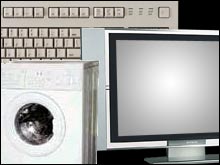Decline in business spending raises alarmsContinued pullback in business spending hits orders for big-ticket items and raises new fears of an economic slowdown.NEW YORK (CNNMoney.com) -- The weakness in the U.S. economy apparently goes beyond the well-publicized problems in the housing and the subprime mortgage sector, as businesses continue to pull back on their spending. A government report on demand for big-ticket items Wednesday came in weaker than expected, damaging the hopes of some economists that strong business spending would help the economy weather the current weakness in housing.
The report showed new orders for durable goods, which range from vehicles and aircraft to machinery, computers and appliances, rose 2.5 percent, compared to a revised 9.3 percent decline in January. Economists surveyed by Briefing.com had forecast a 3.5 percent gain. The original reading for January was a 7.8 percent decline, and many had expected that to be revised higher, not lower. So the overall report outlook on factory orders so far in 2007 was much weaker than expected. Meanwhile, orders for nondefense capital goods other than aircraft, watched by economists as a barometer of business spending, fell 1.2 percent, after a revised 7.4 percent drop in January that now stands as the fifth-biggest decline on record. The original reading for January was a 6 percent drop. Once again, economists had been looking for the February reading to show a rebound from the weak January number, not for additional declines. Federal Reserve Chairman Ben Bernanke cited the weakness in business spending as an area of concern as he testified Wednesday before the Joint Economic Committee of Congress. "The magnitude of the slowdown has been somewhat greater than would be expected given the normal evolution of the business cycle," Bernanke said in his prepared remarks to open the hearing. He did say the Fed is looking for a rebound in this spending later in the year. Despite Bernanke's hopes for gains later this year, the weak numbers in Wednesday's report helped to send stocks lower in early trading Wednesday. "It's more evidence that the economy is on a banana peel," said Jeoff Hall, chief U.S. economist for Thomson Financial, who estimates that the chance of a recession later this year is now about 40 percent. "We had put a lot of stock in the idea that manufacturing would form a bridge while housing went through its tribulations. But it's not looking strong," Hall said. The reading on nondefense capital spending excluding aircraft is now down nearly 5 percent since November, the biggest three-month drop in that closely watched measure in three years. And that key measure is down 9.7 percent since the end of the third quarter. The only months that saw a bigger decline over a five-month period came between April 2001 and January 2002, when the economy was struggling with a recession and the aftermath of the Sept. 11 terrorist attack. "With this report we see it's not just about volatility," said economist Robert Brusca of FAO Economics. "No matter how you cut this thing, we've got tremendous weakness." Brusca is particularly worried that even as shipments of some of these essential durable goods, such as machinery, continue to fall, inventories continue to rise. "That's a bad combination," said Brusca. The demand for machinery slipped 0.4 percent, following a 10.9 percent decline in January. Orders also fell for primary metals and fabricated metal products, showing that heavy industry is putting a brake on new orders in anticipation of weaker demand for their products or excess inventory. Much of the gain in overall orders can be attributed to nondefense aircraft and parts, a volatile sector that jumped 88 percent compared to January orders. Excluding that, overall durable orders would have been down 0.8 percent in the February report. There was also a healthy 6.4 percent increase in orders for computers and electronics equipment. "I thought this report might have showed more of a gain in these orders and shipments because of Vista," said Brusca, referring to the recent introduction of Microsoft's new operating system. "But it's not very strong compared to the downward forces." |
Sponsors
|



